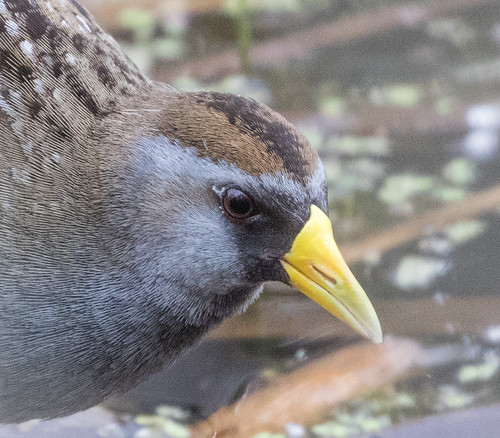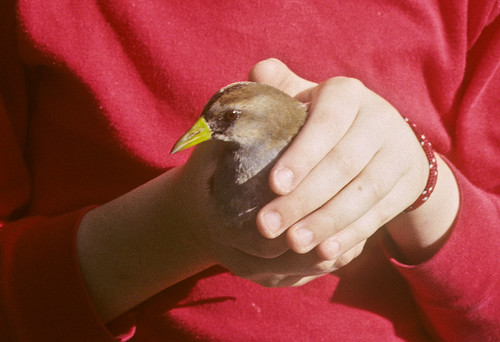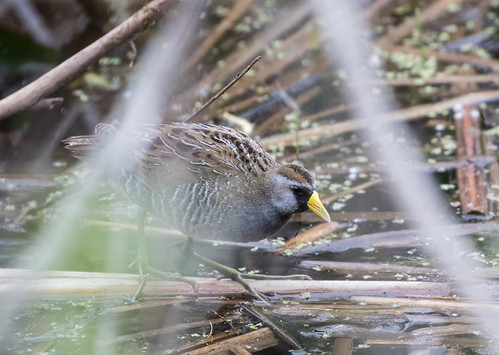Last week, I saw a video making the rounds on social media in which an adorable 5-month old beaver, at a rehab center since it was rescued as a 2-month old, pushed and pulled stuffed animals and other toys, wadded paper, and a small Christmas tree into a colorful dam, rearranging elements as it added new ones. (Here is a link to a different video with a good explanation of how licensed rehabbers deal with baby beavers in a house, with the same adorable dam-building.)
Watching it brought me back to my own rehab days. I took care of a few baby squirrels and three orphaned baby raccoon siblings, but I had much more knowledge about and experience with birds. What the baby beaver video brought back specifically was how both baby and adult birds displayed some innate behaviors even as they adapted those natural behaviors to a very unnatural environment.
I once treated a Sora with a broken leg. I taped the leg at the break and splinted it with a plastic drinking straw I'd slit lengthwise with a razor and cut to the right length. Then I made a sling from a handkerchief to suspend the poor thing for a few days so she wouldn't put any weight on the leg as it mended, and kept her in a quiet room, coming in to offer her food many times a day. When the leg seemed sturdy enough to walk on, I brought her to our living room for a few days longer to make sure she was healthy and healed enough to release.
Soras are defenseless. While I was holding the poor thing, examining her body and then taping and splinting the leg, she never once tried to bite, and didn’t struggle hardly at all. Between her large, beseeching eyes and gentle demeanor, I fell in love with the little thing, instantly becoming more emotionally invested than was probably wise. My kids fell in love with her, too.
Soras are small rails, in the same family with gallinules and coots, and live in marshes. They average 85 grams or about 3 ounces, just about exactly the average weight of a Blue Jay and about the same as the very heaviest robins, making them a perfect-sized meal for a lot of predators. But unlike jays and robins, Soras don’t fly fast and don’t fight back. Hiding is their only defense, so they mostly lurk in dense stands of cattails. They look plump, but their bodies are rather flattened laterally so they can move between stalks without rustling them to give away their location. If I'm very lucky when I’m standing on a platform or boardwalk over a marsh, I might pick one out below, walking leisurely along picking at food items. When one must pass through an opening, it usually scurries across until it reaches cover again. Only rarely have I watched one in an opening for more than a few seconds.
My living room was also the place I often kept my education nighthawk Fred, along with any nighthawks I was rehabbing—they’d snuggle against Fred, whose calm demeanor put the others at ease.
Most of the time, Fred faced the room from under the piano bench, but when the sun was shining through the south window, warming the carpet in the center of the room, he’d waddle over there, the others following. That meant I needed to keep newspapers spread in two distinct areas. When I released the Sora in the room, I figured I’d need to spread papers throughout the room, thinking the Sora would wander more randomly than the nighthawks did.
But nope! I just needed to put papers down along the two walls where the windows were. Our living room is singularly devoid of cattails, and without dense vegetation, the little bird found the next best thing. Our draperies went down to the floor, and the Sora spent just about every minute of every day in the narrow space between a drapery panel and the wall. Our sofa and end tables blocked my access to the floor under the south window, but the east window was accessible, so I kept a shallow dish of mealworms and other food items behind one drapery panel and a dish of water behind the other. When the drapes were open, every now and then the bird would walk quickly through the opening between panels. Otherwise, we could go hours without seeing her.
My living room was also the place neighborhood kids gathered to play with Legos. Most of them walked right in, everyone careful to look where they stepped, paying attention to where the nighthawks might be. The Sora was in the living room for only a few days, but the kids got a big kick out of watching her pass from one drapery panel to the other. The moment anyone noticed her coming out, they’d call out. She was used to me and didn’t scurry away when I brought more food or water, even inches from where she might be standing, and she didn't mind children nearby, either. Her adaptability in this unnatural setting made her recover much more quickly than if she were stressed out or panicky.
Like that baby beaver constructing a dam out of stuffed animals when no appropriate building materials were available, this little Sora made the best of a bad situation to make herself feel at least a little at home while she healed. When I felt certain she was ready for release, my daughter Katie came along to the large marsh at Wisconsin Point. We walked to a nice stand of cattails, Katie carrying her. She gently set the little bird on the open ground right next to the cattails. The Sora blinked a bit, ruffled and shook her feathers out, and headed into the vegetation, not looking back. Within seconds, we could no longer see or hear her.
Knowing she was in there somewhere made the entire marsh seem suddenly richer. I’ve never been able to drive along Wisconsin Point without thinking of this little bird, so adaptable when she needed to be even as she never lost sight of where she really belonged.




